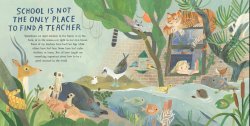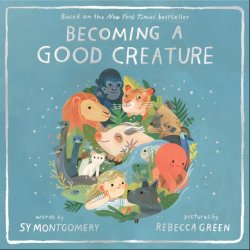
Artwork by Rebecca Green from Becoming a Good Creature © 2020 by Houghton Mifflin Harcourt


Reviewed By Samantha Piede
Many of us in our youth had fanciful visions of what we wanted to be when we grew up. Naturalist Sy Montgomery was no different. In the opening of Becoming a Good Creature (2020), she tells readers that her childhood ambition was “to be a dog” because she wanted to “understand the sounds of [her] neighborhood, both wild and tame.” As such, she spent a great deal of her early childhood ‘doggedly’ following her Scottish terrier, Molly. “So, I watched her. I listened,” she tells readers. “And I learned that if we pay attention, the world outside beckons us.” In the paired illustration, carefully rendered in acrylic by prolific children’s book illustrator Rebecca Green (How to Make Friends with a Ghost), a young Montgomery is pictured kneeling over a mound of earth, following the guide of Molly’s pointed snout. Molly signals towards a tiny earthworm poking out of the soil: something a young human girl might have otherwise missed. Though Montgomery outgrew her canine ambitions, the spirit of this inquiry carried forward into her professional life. She would go on to conduct field research across multiple continents and author 34 books on animal life. Though she has had a prolific career working on a host of zoological ventures with figures like Temple Grandin and networks like National Geographic, she still credits Molly with being her “first teacher.”
Becoming a Good Creature is an abridged version of Montgomery’s best-selling memoir, How to Be a Good Creature (2018), retooled for a younger audience. The book outlines a series of encounters she has had with animals: both domestic (her pet pig named for conductor Christopher Hogwood; her border collie, Thurber, with one blind eye) and wild (the emu family she follows in Australia; the gorillas she meets in Zaire). Montgomery titles each section of the picture book with a moral lesson she has learned from her interactions with other species, such as “Love Little Lives,” “Don’t Be Afraid,” and “Make Your Own Family.” This is not, however, a morally didactic move on her part; to simply extract the lessons and leave the anecdotes is to miss the keystone of what holds the larger structure of the book together. Rather, Montgomery frames each of these lessons as predicated on our receptivity to other lives. Our willingness to be attentive to other creatures – not just the ones like us with “two legs,” but also “four or even eight” – opens up the possibility of finding something ethically significant in these encounters. She tells us that “all have taught me something important about how to be a good creature in the world.”
Significantly, Montgomery never defines her idea of “goodness” in explicit terms. Instead, her sense of how we approach ‘becoming a good creature’ is predicated on having these sorts of educative experiences with non-human creatures: on learning to see as they see. This is what is referred to, in philosophical terms, as expanding the moral imagination: our ability to act better is enabled by our ability to see more of the world as it actually is. This explains Montgomery’s emphasis on from whom we can be ‘taught’. Framing the animals in each of the book’s anecdotes not simply as objects of observation, but as teachers grants them their own epistemology, their own ways of knowing, from which there is so much that we can learn.

Artwork by Rebecca Green from Becoming a Good Creature © 2020 by Houghton Mifflin Harcourt
Throughout the book, Montgomery challenges anthropocentricity by encouraging readers to consider animals not merely in their relation to humans, but also as having their own integrity. This comes across especially strongly in the lesson “Learn Forgiveness,” which recounts Montgomery’s interactions with a white-coated weasel who breaks into her chicken coop. She tells readers, “Though tiny, weasels are fierce. They catch and eat animals much bigger than themselves. They even eat chickens!” Given these circumstances, one might be inclined to view the weasel as primarily a menace: a malevolent force bent on destroying one’s property and killing innocent hens. Instead, Montgomery recounts “look[ing] into the weasel’s black eyes” and thinking, “How brave he was! And how beautiful, in his snowy winter coat.” She recognizes that the act of breaking into a hen house during a winter storm — a time when subsistence is scarce — is an act of survival. The meaning of the act transforms; it becomes one for which she “couldn’t be angry.” Through seeing this encounter through the creature’s eyes, Montgomery is able to forgive the weasel.
Likewise, in “Find Common Ground,” Montgomery establishes that we do not need to see ourselves as entirely similar to an animal in order to find areas of commonality. Here, she recalls her interactions with an octopus at the New England Aquarium. “Octavia had eight arms, three hearts, no bones,” Montgomery relays. “She lived in the water. I live on land. What could we possibly have in common?” After some time, they discover a way of interacting with one another that is mutually satisfying: their shared love of play, through which they could communicate with one another and “became friends.”
The breadth of Montgomery’s ethical encounters with wildlife offers points of reflection for readers of all ages. If Montgomery can have these sorts of experiences with animals that are familiar (like her dog Molly) and ones that are far removed from human life (the weasel, the octopus), perhaps there is potential to draw ethical wisdom from any living creature. Reading this book, students are primed to pay close attention to other species as sources of knowledge and ask themselves: “How might a creature that is equipped for this world so differently from me be attuned to something in this world that I cannot see on my own? And what might I learn from this encounter about being a better creature myself?” Students with pets may be especially equipped to offer lived examples from their homes: a dog who senses before we do that someone is at the door; a cockatoo who picks up on ultraviolet light. Teachers interested in extending the experience may even consider offering opportunities for nature study, asking students to keep a ‘science journal’ through which enter into close observation of the same sort of creature over regular, sustained periods of time. These recognitions may encourage readers to take up Montgomery’s stance towards the myriad other species with whom we share the world: to approach them with the kind of deep respect and curiosity that makes us receptive to what they have to teach us.